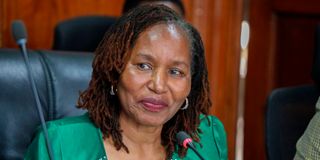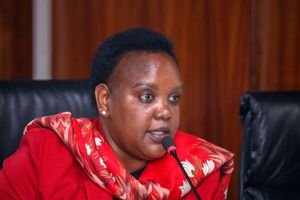
Child Welfare Society of Kenya Ludeki Chweya.
The fate of 700,000 children under the Child Welfare Society of Kenya (CWSK) hangs in the balance following the decision by the government to merge state-owned enterprises in a bid to cut operational costs.
Among the agencies affected by the January decision by the Cabinet is CWSK, which now faces closure.
The society told the Social Protection Committee of the National Assembly yesterday that the cut in funding means it will no longer be able to care for the children, thus exposing them to the social dangers from which they have been rescued.
CWSK trustee, Ludeki Chweya, told the lawmakers that among the most affected are 2,700 lost children who the society is trying to reunite with their families.
The fate of at least 171,000 children in primary or secondary schools, colleges and universities the society sponsors also hangs in the balance.
The society said 50,000 children rescued from labour would also be affected by the cut in funding.

Child Welfare Society of Kenya CEO Irene Mureithi when she appeared before the National Assembly Public Investments Committee on Social Services, Administration, and Agriculture at the Parliament buildings in Nairobi on Tuesday, April 9, 2024.
Mr Chweya told the National Assembly team that 206,000 children from poor families and others who have been orphaned would have to be released.
According to the agency, there are 3,000 infants in its care as part of its Rapid Rescue Initiative. These children were abandoned at the hospital or were foundlings.
“We picked some of these babies when they were just two hours old. Where do they go when funding stops?” Mr Chweya asked.
The CWSK added that it is involved in projects to build homes for children in many parts of the country, “which are fully funded by the government and could not become a white elephant”.
The society said it is building such homes in Nairobi, Bungoma, Isiolo, Murang’a and Nanyuki.
“These projects are 85 per cent complete. If funding is withdrawn, they will stall,” Mr Chweya said.
National Assembly Social Protection Committee chairman, Alice Ngang’a, said the matter is sensitive as it concerns vulnerable children.
“We are not dealing with infrastructure; we are dealing with the children of Kenya. We will have failed as a society if we remain silent,” Ms Ng’ang’a said.
“If we stop the funding, who will take care of the 700,000 vulnerable children? What will happen to the homes being built?”
Committee Deputy Chairperson Hillary Kosgei said the fate of the children should not be decided by the Cabinet.
“The CWSK has been in existence for 70 years and donors have supported it. If donors see that the government does not care about its children, why should they continue support? This is risky,” Mr Kosgei said.
Seme MP, James Nyikal, said the committee would demand an impact assessment report from Cabinet and other reasons that informed the funding to the CWSK.
Labour and Social Protection CS Alfred Mutua said he attempted to persuade the Cabinet to reverse its decision.
“I spent 20 minutes defending the child welfare funding but was unsuccessful. The mood in Cabinet was that there should be changes in parastatals,” he told the MPs.
Mr Mutua said one of the requests he made during the Cabinet meeting was for a phased approach to the funding of the Child Welfare Society, which was also rejected.
He said the ministry had already written to the National Treasury for additional funding to take over the functions initially undertaken by the society.
Last month, the Cabinet approved the merger of some 42 state-owned enterprises, reducing the number to 20, in a bid to cut costs and improve efficiency.
The Cabinet said the merger of the 42 state enterprises was aimed at improving operational efficiency and eliminating redundancies.







